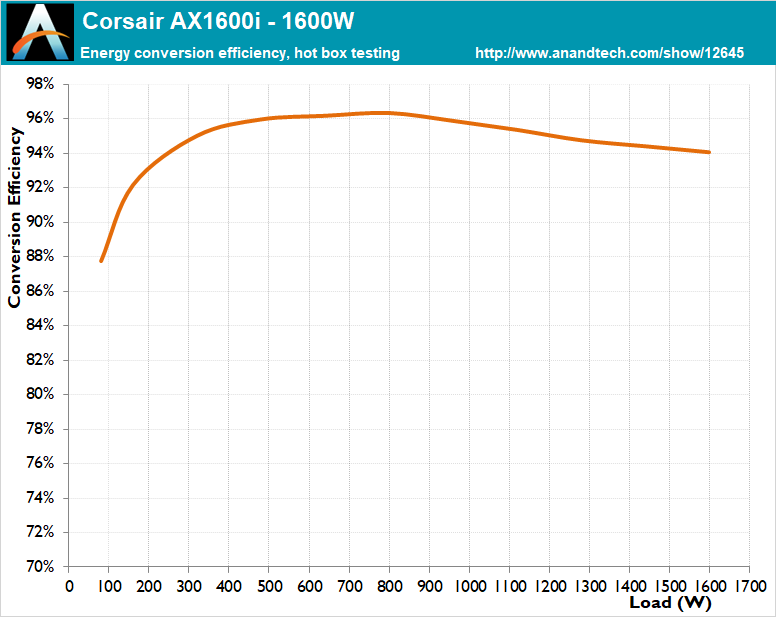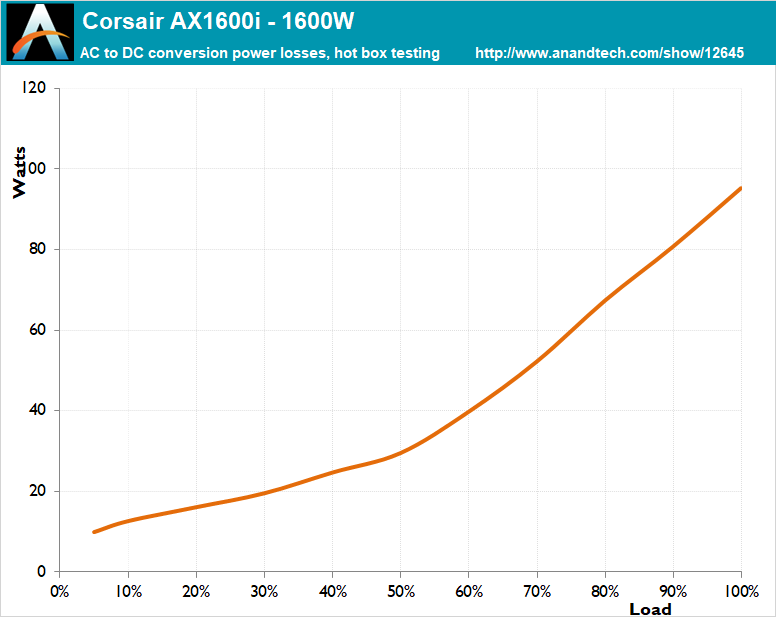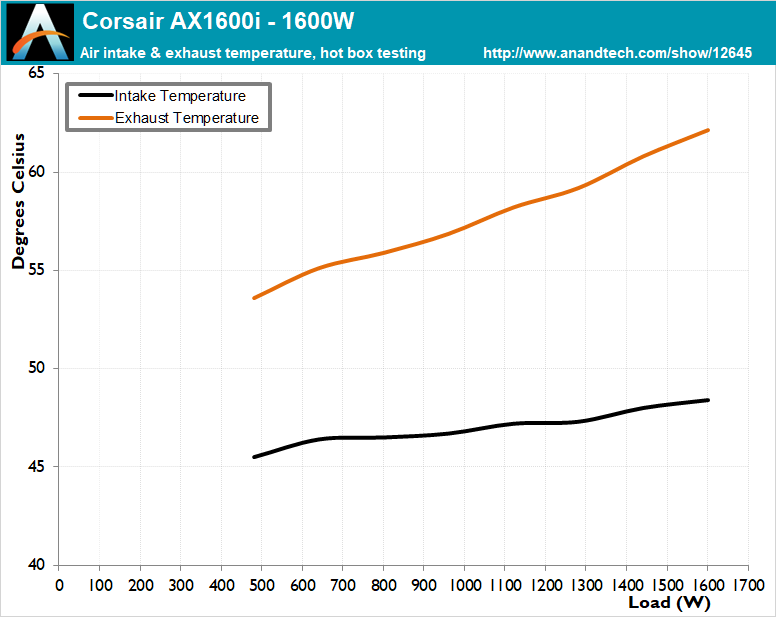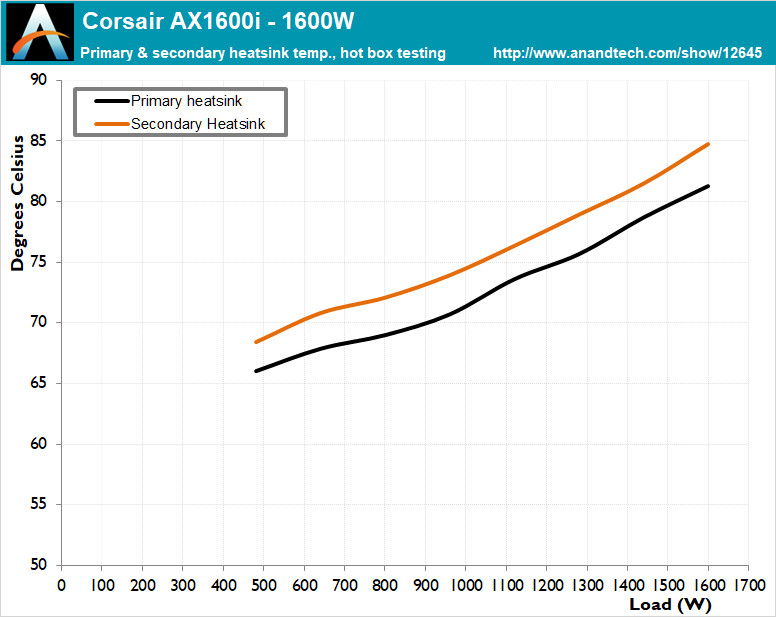The Emperor of Efficiency: Corsair's AX1600i PSU Rules Alone (Review)
by E. Fylladitakis on April 18, 2018 9:30 AM ESTHot Test Results
The Corsair AX1500i already was the benchmark of electrical quality, leaving very little room for improvement. Although the AX1600i might appear to deliver a little bit better power quality, the truth is that we would need very high precision equipment to tell the difference between the two, and any difference would be unimportantly small. However, that does not lessen the fact that the AX1600i delivers possibly the best power quality that can be bought at this point of time. For the most part, the voltage ripple of any line is less than ten millivolts. The maximum ripple on the 12V line is just 14 mV and that is with a massive current draw of almost 124 amperes. The voltage regulation is equally impressive, with a variation of just 0.2% on the 12V line across the nominal load range. Voltage regulation is a little bit worse on the 3.3V/5V lines, at 0.4%/0.25% respectively, which figures still are a lot better than what most current high-performance PSUs can achieve.
| Main Output | ||||||||
| Load (Watts) | 321.91 W | 804.24 W | 1205.17 W | 1606.8 W | ||||
| Load (Percent) | 20.12% | 50.26% | 75.32% | 100.42% | ||||
| Amperes | Volts | Amperes | Volts | Amperes | Volts | Amperes | Volts | |
| 3.3 V | 2.78 | 3.33 | 6.96 | 3.33 | 10.44 | 3.31 | 13.92 | 3.31 |
| 5 V | 2.78 | 5.05 | 6.96 | 5.05 | 10.44 | 5.04 | 13.92 | 5.03 |
| 12 V | 24.74 | 12.07 | 61.85 | 12.06 | 92.78 | 12.05 | 123.71 | 12.05 |
| Line | Regulation (20% to 100% load) |
Voltage Ripple (mV) | |||||
| 20% Load | 50% Load | 75% Load | 100% Load | CL1 12V |
CL2 3.3V + 5V |
||
| 3.3V | 0.4% | 6 | 10 | 12 | 12 | 4 | 10 |
| 5V | 0.25% | 4 | 6 | 10 | 10 | 6 | 12 |
| 12V | 0.2% | 6 | 8 | 10 | 14 | 12 | 6 |
When it comes to adverse ambient conditions, the Corsair AX1600i is a true fortress. Operating the AX1600i inside our hotbox had virtually no impact on its electrical performance and/or efficiency. Even though the ambient temperature was well over 45 °C, the efficiency drop across the entire range was a mere 0.1%. This suggests that the components of the AX1600i are far from getting thermally overstressed, even with the PSU operating at maximum output under these adverse conditions.
The only thing inside the AX1600i that is affected by the high ambient temperature is the cooling fan. It will still not even start with a load below 460 Watts but it is livelier once it does start, increasing its speed at a higher rate as the load increases. It ultimately reaches about 45.5 dB(A) at maximum load, which would be a low figure even for a mainstream PSU with an output of some hundred Watts, yet the AX1600i manages to maintain comfortable noise levels operating at maximum load with an ambient temperature of over 48°C. The internal temperatures of the PSU also are very low taking its power output and low fan speed into account.















39 Comments
View All Comments
TelstarTOS - Wednesday, April 18, 2018 - link
Now, please scale down this platform and gimme an 800W AXI with a pricetag of 300W and I'll buy it for my next system.SirPerro - Wednesday, April 18, 2018 - link
Well that's exciting.Now build one of those for normal people.
Ninjawithagun - Thursday, May 10, 2018 - link
Um, define 'normal people' please?baka_toroi - Wednesday, April 18, 2018 - link
Isn't this the perfect mining PSU?Ryan Smith - Wednesday, April 18, 2018 - link
Too expensive. There's actually a passage I cut from the article that I'll go ahead and post here."One could argue that the PSU might be appealing to cryptominers, but we find that to be unlikely. Cryptominers usually only care about having a reliable high output regardless of the power quality or noise, and thus prefer to source regular >2 kW designs that sell for a fraction of the AX1600i's price"
zodiacfml - Wednesday, April 18, 2018 - link
Correct. Server grade PSUs are being used for mining. There are Chinese branded PSUs with similar capacity and efficiency not far from the Corsair but just above $100.I just read somewhere that it is actually easier to make a more efficient PSU with high capacity, around 1KW and above.
The_Assimilator - Wednesday, April 18, 2018 - link
$100, you are smoking your socks. Unless you're willing to buy something that some random dude has spliced a bunch of PCIe connectors onto and only gives a 30-day warranty on.gavbon - Wednesday, April 18, 2018 - link
I don't think I have spent less than $150 on a PSU in the last 5 years - Obviously price tag doesn't necessarily equate to quality, but you're more likely to buy quality at higher price points...as this review proves, this unit is TOP quality, but you're always going to pay big bucks for itAdrianB1 - Wednesday, April 18, 2018 - link
You can buy a Corsair with 2 year warranty for $75 in my part of the world (Europe). Semi-modular, not 80 Plus Titanium rated, but still a very decent PSU. Same for Antec or other brands, you can find a decent Fortron much cheaper. Most computers you buy here have ~$25 PSU + case combo and they are covered by 2 year warranty that you can extend to 4 years and the reliability is surprisingly good. Building PSU's is no rocket science anymore.Spazilton - Wednesday, April 18, 2018 - link
They are using stuff like this. https://www.ebay.com/itm/Supermicro-PWS-1K21P-1R-1...